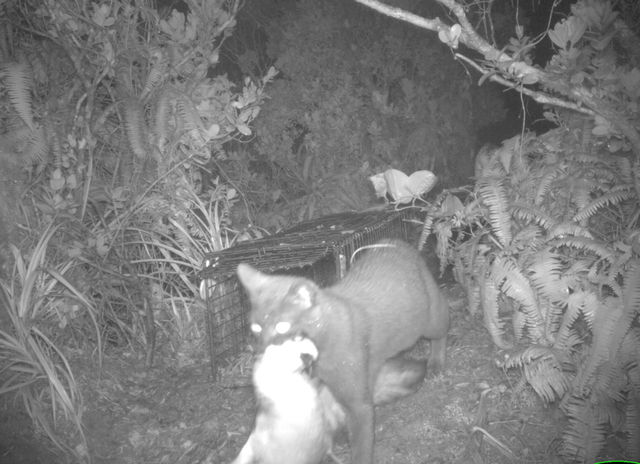NAPALI — A mountain cat was caught on camera picking off two Hawaiian Petrels last week, but researchers say the feral feline is actually responsible for recently killing six of the endangered birds. The bodies were discovered at a remote
NAPALI — A mountain cat was caught on camera picking off two Hawaiian Petrels last week, but researchers say the feral feline is actually responsible for recently killing six of the endangered birds.
The bodies were discovered at a remote breeding colony in Hono O Napali Natural Area Reserve, according to the state Department of Land and Natural Resources, where the Kauai Endangered Seabird Recovery Project monitors 67 burrows. The colony is one of the five main Hawaiian Petrel breeding colonies monitored on the island.
“It’s almost certain it’s the same cat that killed all six of these birds,” said Andre Raine, project coordinator for the Kauai Endanger- ed Seabird Recovery Project. “Over the last few weeks, we’ve seen this same cat show up, and now we’ve got the video of the one being eaten and the photo of the cat carrying another Petrel.”
Raine explained it’s not just cats that predate on Hawaiian Petrels — black rats, barn owls, and pigs also target the endemic birds. The manner in which the birds were killed, though, points to cats because rats target chicks and the young fledglings, owls pick the bird apart differently than a cat would, and with pigs, there are “just pieces all over the place.”
“Cats cause very clear injuries to birds compared to the other species,” Raine said. “When you look at the carcass, you can deduce the species (of attacker).”
Raine said the incident happened in an area that already has an active cat control program with traps.
“So even when we are actively controlling, some cats can slip through and do damage,” Raine said. “It highlights how important it is to keep controlling invasive predators.”
Sheri Mann, the Kauai Branch Chief for the DLNR Division of Forestry and Wildlife, said predator control efforts should be the last line of defense for the colonies.
“The fact that we have cats slipping through, highlights how dire the feral cat issue is on Kauai and that control efforts solely in wilderness areas are not enough to fully deal with this problem,” she said. “It will take a concerted effort by the island community as a whole to protect native species.”
Basil Scott of the Kauai Community Cat Project said he feels it’s “too bad this predation is occurring” and that these types of killings always bring up the conversation about the feral cat population on the island.
“There are really two different kinds of feral cats on the island — there are the mountain cats and there are the McDonald’s cats hanging out in Lihue,” Scott said. “The cat living at McDonald’s is a vastly different animal.”
He pointed out management of the “McDonald’s cats” is more of a social and community focused effort. Keeping the mountain cat population in check is more of a wildlife management issue.
“The fact that these cats are in these remote areas shows that they’re everywhere and the species can survive in many different areas,” Scott said.
Raine explained that feral cats — especially those in the mountains, generally have large territories and will remember which burrows proved successful when they’re hunting.
“They’ll hit one site and maybe take out a couple of birds and then they’ll move on and come back a month or two later,” Raine said. “And they’re breeding, which means you get kittens that are being taught to kill, so typically we see a flurry of cat activity and it’s a cyclical thing.”
Raine and Scott both pointed out that feeding the cats, even if it’s just one hungry furball on a deserted coast trail, is a bad idea because it increases the cat concentration in that area.
“If you look at the camping areas at the Kalalau Beach where people don’t properly dispose of food, that brings in the rats,” Scott said. “That’ll also pull in the cats.”
According to DLNR, Hawaiian Petrels breed on Kauai from April to December and nest in burrows that they dig in the ground under ferns and at the base of large trees. They incubate a single egg and are “extremely vulnerable to cats and other predators who can get into burrows and kill them.”
Raine said in the last two years, at least 48 endangered seabirds were killed by feral cats, “and this just represents the tip of the iceberg.”
Though there are ways to mitigate the problem and efforts to conserve the population of Hawaiian Petrels is in full swing, Raine said it dampens spirits when the birds are killed.
“It’s a serous threat to our endangered wildlife and it’s a real shame,” Raine said. “These native birds are found only on the Hawaiian Islands and are now restricted to these areas, but in these areas they’re still not safe. They need conservation and protection.”


